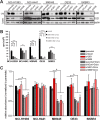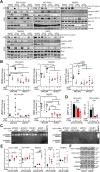The FAM3C locus that encodes interleukin-like EMT inducer (ILEI) is frequently co-amplified in MET-amplified cancers and contributes to invasiveness
- PMID: 33596971
- PMCID: PMC7890988
- DOI: 10.1186/s13046-021-01862-5
The FAM3C locus that encodes interleukin-like EMT inducer (ILEI) is frequently co-amplified in MET-amplified cancers and contributes to invasiveness
Abstract
Background: Gene amplification of MET, which encodes for the receptor tyrosine kinase c-MET, occurs in a variety of human cancers. High c-MET levels often correlate with poor cancer prognosis. Interleukin-like EMT inducer (ILEI) is also overexpressed in many cancers and is associated with metastasis and poor survival. The gene for ILEI, FAM3C, is located close to MET on chromosome 7q31 in an amplification "hotspot", but it is unclear whether FAMC3 amplification contributes to elevated ILEI expression in cancer. In this study we have investigated FAMC3 copy number gain in different cancers and its potential connection to MET amplifications.
Methods: FAMC3 and MET copy numbers were investigated in various cancer samples and 200 cancer cell lines. Copy numbers of the two genes were correlated with mRNA levels, with relapse-free survival in lung cancer patient samples as well as with clinicopathological parameters in primary samples from 49 advanced stage colorectal cancer patients. ILEI knock-down and c-MET inhibition effects on proliferation and invasiveness of five cancer cell lines and growth of xenograft tumors in mice were then investigated.
Results: FAMC3 was amplified in strict association with MET amplification in several human cancers and cancer cell lines. Increased FAM3C and MET copy numbers were tightly linked and correlated with increased gene expression and poor survival in human lung cancer and with extramural invasion in colorectal carcinoma. Stable ILEI shRNA knock-down did not influence proliferation or sensitivity towards c-MET-inhibitor induced proliferation arrest in cancer cells, but impaired both c-MET-independent and -dependent cancer cell invasion. c-MET inhibition reduced ILEI secretion, and shRNA mediated ILEI knock-down prevented c-MET-signaling induced elevated expression and secretion of matrix metalloproteinase (MMP)-2 and MMP-9. Combination of ILEI knock-down and c-MET-inhibition significantly reduced the invasive outgrowth of NCI-H441 and NCI-H1993 lung tumor xenografts by inhibiting proliferation, MMP expression and E-cadherin membrane localization.
Conclusions: These novel findings suggest MET amplifications are often in reality MET-FAM3C co-amplifications with tight functional cooperation. Therefore, the clinical relevance of this frequent cancer amplification hotspot, so far dedicated purely to c-MET function, should be re-evaluated to include ILEI as a target in the therapy of c-MET-amplified human carcinomas.
Keywords: C-MET; Cancer; FAM3C; Gene amplification; Interleukin-like EMT inducer (ILEI); Invasion; Matrix metalloproteinase (MMP).
Conflict of interest statement
The authors declare that they have no competing interests.
Figures








Similar articles
-
Covalent dimerization of interleukin-like epithelial-to-mesenchymal transition (EMT) inducer (ILEI) facilitates EMT, invasion, and late aspects of metastasis.FEBS J. 2017 Oct;284(20):3484-3505. doi: 10.1111/febs.14207. Epub 2017 Sep 14. FEBS J. 2017. PMID: 28837266
-
The ubiquitin ligase UBE4A inhibits prostate cancer progression by targeting interleukin-like EMT inducer (ILEI).IUBMB Life. 2017 Jan;69(1):16-21. doi: 10.1002/iub.1585. Epub 2016 Nov 10. IUBMB Life. 2017. PMID: 27862841
-
Interleukin-like EMT inducer (ILEI) promotes melanoma invasiveness and is transcriptionally up-regulated by upstream stimulatory factor-1 (USF-1).J Biol Chem. 2018 Jul 20;293(29):11401-11414. doi: 10.1074/jbc.RA118.003616. Epub 2018 Jun 5. J Biol Chem. 2018. PMID: 29871931 Free PMC article.
-
FAM3C: an emerging biomarker and potential therapeutic target for cancer.Biomark Med. 2021 Apr;15(5):373-384. doi: 10.2217/bmm-2020-0179. Epub 2021 Mar 5. Biomark Med. 2021. PMID: 33666514 Review.
-
Dysadherin: a new player in cancer progression.Cancer Lett. 2007 Oct 8;255(2):161-9. doi: 10.1016/j.canlet.2007.02.018. Epub 2007 Apr 17. Cancer Lett. 2007. PMID: 17442482 Free PMC article. Review.
Cited by
-
An integrated study to decipher immunosuppressive cellular communication in the PDAC environment.NPJ Syst Biol Appl. 2023 Nov 10;9(1):56. doi: 10.1038/s41540-023-00320-6. NPJ Syst Biol Appl. 2023. PMID: 37945567 Free PMC article.
-
FAM3C/ILEI protein is elevated in psoriatic lesions and triggers psoriasiform hyperproliferation in mice.EMBO Mol Med. 2023 Jul 10;15(7):e16758. doi: 10.15252/emmm.202216758. Epub 2023 May 25. EMBO Mol Med. 2023. PMID: 37226685 Free PMC article.
-
FAM3C in circulating tumor-derived extracellular vesicles promotes non-small cell lung cancer growth in secondary sites.Theranostics. 2023 Jan 1;13(2):621-638. doi: 10.7150/thno.72297. eCollection 2023. Theranostics. 2023. PMID: 36632230 Free PMC article.
-
Single-cell characterization of self-renewing primary trophoblast organoids as modeling of EVT differentiation and interactions with decidual natural killer cells.BMC Genomics. 2023 Oct 18;24(1):618. doi: 10.1186/s12864-023-09690-x. BMC Genomics. 2023. PMID: 37853336 Free PMC article.
-
CD44+ and CD133+ Non-Small Cell Lung Cancer Cells Exhibit DNA Damage Response Pathways and Dormant Polyploid Giant Cancer Cell Enrichment Relating to Their p53 Status.Int J Mol Sci. 2022 Apr 28;23(9):4922. doi: 10.3390/ijms23094922. Int J Mol Sci. 2022. PMID: 35563313 Free PMC article.
References
-
- Hyman E, Kauraniemi P, Hautaniemi S, Wolf M, Mousses S, Rozenblum E, et al. Impact of DNA amplification on gene expression patterns in breast cancer. Cancer Res. 2002;62(21):6240–6245. - PubMed
MeSH terms
Substances
Grants and funding
LinkOut - more resources
Full Text Sources
Other Literature Sources
Medical
Molecular Biology Databases
Miscellaneous

